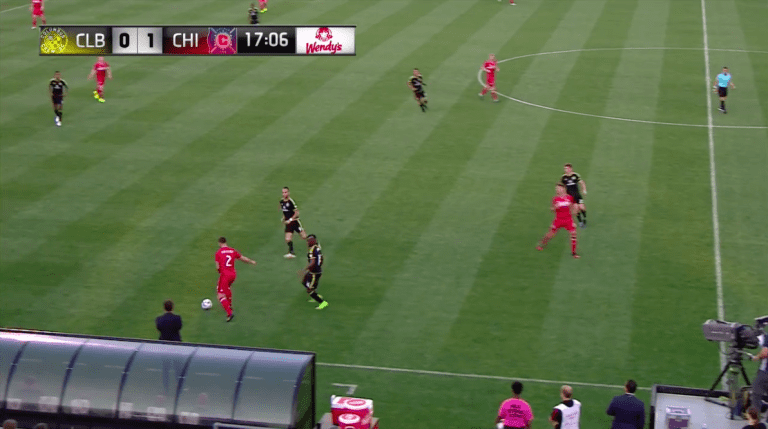Each week, Sam Polak breaks down the top coaching moves in MLS from the previous week. Here are his top five from Week 23.
5. Seattle sub key to seeing out final 30 minutes
The Seattle Sounders' 1-0 win against Sporting Kansas City featured a great game-winning goal from Clint Dempsey, but head coach Brian Schmetzer put his stamp on this game, as he has a couple times already this season, with a quality decision to bring on Osvaldo Alonso in the 59th minute.
This change had the obvious benefit of giving Alonso the opportunity to start to regain some of his fitness, having missed some time with an injury, but it was also the correct player to put in to solve some of the problems the Sounders were having and to see the match through.
Seattle had struggled a bit to find the right movement to disrupt Sporting KC’s defensive shape in addition to finding simple passes from their backs into their midfielders like the sequence below.
Once Alonso came in, their possession and movement looked like this.
As Schmetzer noted in his postgame address to the team, Alonso provided needed composure for Seattle. And it was this decision to bring in Alonso’s combination of situational awareness and assuredness on the ball that helped the Sounders secure all three points.
4. Red Bulls upping the pressure
One of the challenges of coaching is finding the right balance between how much your team should react to what an opponent does contrasted with how much you should impose your style and force an opponent to react to you. Saturday night's New York Red Bulls-Orlando City SC clash was an example of a game where Red Bulls Jesse Marsch got that balance right.
Recognizing Orlando were starting a new center back pairing, Marsch and his staff had their team put more pressure on Orlando’s Leo Pereira and Tommy Redding.
Imposing this mentality worked well for the Red Bulls. It would have likely just been easier for Tyler Adams' to play a pass backwards that would have surely kept possession in the 30th minute. Instead he swung the ball in toward goal after a 1v1 and created a problem for Orlando’s fill-in center back Pereira, who put the ball in his own net. Similarly for their third goal, it would have been easier to take what was given from Orlando and just try to possess calmly out of a throw-in. Instead, Sean Davis spun away from two defenders and drove centrally before scoring.
Having his team ask questions of Orlando’s Pereira and Redding, whether or not it may have even been forced, Marsch created a type of match that wasn’t always pretty but gave his side the advantage.
3. Ilsinho shadow
Montreal, sitting just outside the top six teams in the Eastern Conference, got a much-needed three points against the Philadelphia Union over the weekend. The Union came into the match off a solid 3-1 performance against FC Dallas; however, Mauro Biello was prepared with a game plan to keep Jim Curtin’s team from being as dangerous.
Biello had his Montreal Impact shut down what he saw as the Union’s greatest attacking threat: Ilsinho. Biello and the coaching staff had reason to want to eliminate his influence on the game — Ilsinho was involved in all three of the Union’s goals last weekend including a clever one-two that led to the first goal.
Interestingly though, Biello tasked Samuel Piette, in his first ever start and first ever minutes in the MLS, with the primary responsibility of tracking Ilsinho and worrying about other defensive responsibilities second.
Mauro Biello using his newest member of the Montreal Tmpact so shadow the Philadelphia Union's Ilsinho pic.twitter.com/HIuKOb39Cv
— sam (@11v11Sam) August 14, 2017
This plan and the use of a player who hasn’t had any time with the Impact prior to this match was a bold yet effective strategy to limit what Montreal saw as the Union’s most important part of their attacking play. Biello’s strategy and Piette’s execution did not shut Philadelphia and Ilsinho down completely, but it certainly played a role in Montreal’s clean sheet.
2. Crew SC trapping Chicago’s outside backs
Columbus Crew SC won a huge game on Saturday, beating the Chicago Fire 3-1, and they got both the tying and go-ahead goals thanks to the defensive scheme set up by their coaching staff.
Throughout the match, as the Fire would look to play out of their defensive third, Columbus set up to invite a pass centrally into midfield. Once the ball came in, they would force the next pass to go outside to the Fire’s right or left back. At this time, Columbus would promptly isolate the Chicago player along the sideline and force a turnover.
Below, Matt Polster was completely trapped after Crew SC funneled Chicago into the situation just described. Polster, with no clear good option, gave the ball up here and this led to the Columbus’ first goal.

It was a strikingly similar situation that led to Columbus’ second goal additionally— Polster ended up pinned along the side after a square pass from the Chicago midfield. Columbus then created a turnover that led to a Justin Meramfinish.
This was a brilliant set-up by Berhalter and his staff. It not only led to two goals as already mentioned, but forced Chicago back when in possession to avoid this trap.
1. Vanney's second-half adjustments
Greg Vanney’s Toronto FC went on a four-goal scoring spree in the second half of their match against the Portland Timbers, after being held to just one shot on target during the first 45 minutes. The coaching staff’s adjustments at halftime were pivotal in propelling TFC to a win.
Through the first half, the Reds were quite simply too nice to their opposition – they went forward with too few players (often just three players only to be met by at least Portland’s four defenders), they moved the ball too slowly and they progressed down the side of the field when it would have been far more dangerous to attack down the middle. Portland weren't particularly brilliant during the first half, Toronto just did them a number of favors.
Vanney corrected all of this as his side emerged from the intermission with a different approach. Toronto’s first goal in the 58th minute featured an attack with five players, the ball moving much quicker – arriving in the final third from the defensive third with one or two touch passes in about eight seconds, and the entire attack started down the central channel of the field.
It was more of the same during Toronto’s second goal. They promptly took advantage of spaces that opened up, they drove the ball centrally, and they committed five (arguably six) players to the attack.
There are multiple reasons TFC has the most points in the league at the moment: quality players, depth of the squad, motivation from just coming up short last year. But Vanney and his staff’s contributions, especially visible in matches like this one, are a major advantage for an already impressive team.













